Iranian gardens are among the oldest in the world. With their beautiful design, they offer a delightful and joyful place for creating memorable moments. Regarded as some of the most beautiful gardens globally, these serene and lush Iranian gardens are found throughout the country, especially in desert cities. Constructed over various periods, the Pasargadae Garden in Shiraz is considered the oldest Iranian garden and the model for others. This garden, along with eight others like the Shazdeh Mahan and Dowlat Abad in Yazd, was inscribed in the UNESCO World Heritage List in 2011. In this article in Parsi Tours’ blog we aim to introduce a chain of Iran tourist spots; the nine UNESCO-listed Iranian gardens.
What is an Iranian Garden?
An Iranian Garden reflects the full spectrum of nature, art, and Iranian culture, dating back at least to the Achaemenid period. The Arabic word “Firdaus” and the English word “Paradise are derived from the Persian “Pardis”.
The main features of an Iranian garden are the Chaharbagh, a central pavilion or mansion, water channels, walls, tall peripheral trees, and a water pond. Iranian gardens are historically linked to the advent of qanats, with most situated along qanat outflows.
Pasargadae Garden in Shiraz
The Pasargadae Garden in Shiraz, known as the mother of Iranian gardens, dates back to the Achaemenid era. This garden served as a model for subsequent gardens, including the Safavid gardens and even the royal gardens of India.
The Royal Pasargadae Garden complex includes the royal garden water channels, pavilions, and a bridge. The garden was filled with various trees and colorful flowers, with water supplied through channels from the Polvar River or the Bonab spring. Archaeologists have uncovered about 1,100 meters of the garden’s water features, which, besides transporting water, also had a decorative function and added beauty to the garden. Along the water channels, there were square stone pools, each measuring one meter squared, that gently carried the water, reducing silt and mud.
The Pasargadae Garden had several pavilions, of which only the remnants of two, known as Pavilions A and B, remain in the east and south of the garden. These pavilions, with their simple structures reminiscent of the Pasargadae palaces, were situated amidst lush and picturesque landscapes. A stone bridge, another part of the Pasargadae Garden, was discovered near the Gate Palace. This bridge was over a waterway branching from the Polvar River, likely dating to the late Achaemenid period or even later.
Shazdeh Mahan Garden in Kerman
Shazdeh Mahan Garden, located near the desert city of Kerman, is another beautiful Iranian garden with a history dating back to the Qajar period. It was built by Mohammad Hassan Khan, the ruler of Kerman at the time, and further expanded by the subsequent ruler.
Shazdeh Mahan in Kerman is an excellent example of terraced gardens, considered one of the best in Iran. This garden showcases the flow of water in a beautiful, cascading manner across horizontal and vertical levels. Covering about 5 hectares, the garden measures 407 meters in length and 122 meters in width.
The entrance, mansion, bathhouse, irrigation network, and water pond are the main components of the garden, enclosed by tall trees, creating a lush oasis in the desert. Facilities like a restaurant, guest house, and handicraft stalls are available in the garden.
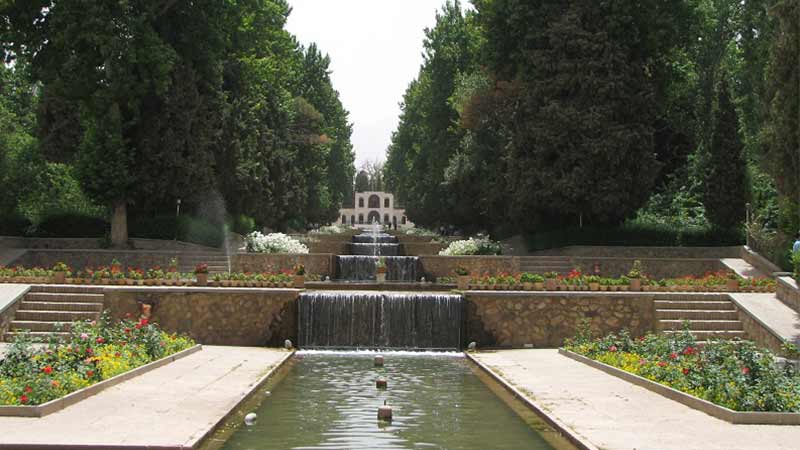
Eram Garden in Shiraz
Eram Garden, the jewel of Shiraz’s gardens and one of Iran’s nine global gardens, dates back to the Seljuk and Inju periods. It was built by Atabak Qaraja, the governor of Fars during the reign of Sanjar Shah Seljuk. Karim Khan Zand later made significant contributions to its construction. For 75 years during the Qajar era, the garden was in the hands of the Qashqai tribal leaders, who built a mansion there. The current mansion was built during the reign of Naser al-Din Shah Qajar.
The Eram Garden mansion in Shiraz, built in the Qajar period inspired by Zand architecture, is a three-story building with a two-story central porch. Its upper part features a crescent moon with tilework depicting historical, literary, and mythical characters.
Registered as a national site in 1974, the garden is currently managed by Shiraz University and is recognized as a botanical garden due to its vast plant diversity. The rose garden and cypress trees, along with stunning architecture, create a pleasant and serene environment.
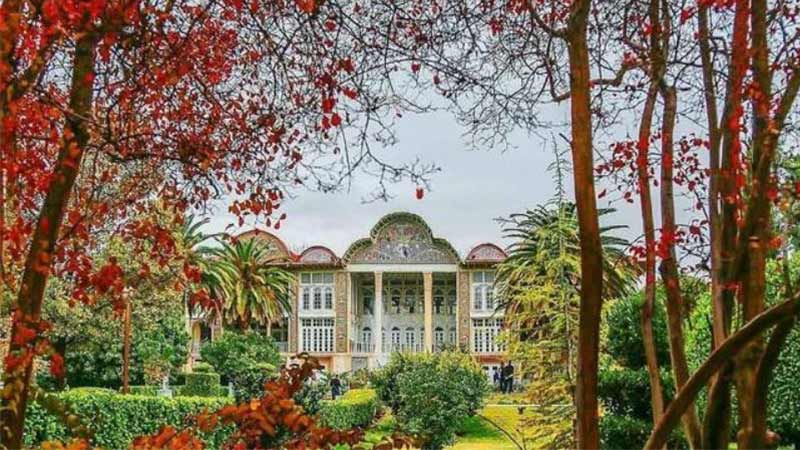
Chehel Sotoun Garden in Isfahan
Chehel Sotoun Garden, or Chehel Sotoun Palace Museum in Isfahan, is an example of a royal garden and one of the three important palaces remaining from the Safavid era. Spanning 67,000 square meters, the garden was transformed into a museum in 1948, displaying parts of the Safavid era.
The garden was established by Shah Abbas I and featured a central mansion built in the European hat style, considered the initial core of the palace. During Shah Abbas II’s reign, the mansion was expanded with halls, porches, two large northern and southern rooms, side porches of the royal hall, a large pool in front of the hall, and decorative paintings, mirror work, tilework on the walls and ceilings.
The main porch of the Chehel Sotoun Palace introduced a new style in Iranian architecture. Unlike other porches enclosed on three sides, this one is open on three fronts and closed on one. The porch has 20 columns, some believing the palace’s name derives from the reflection of these columns on the beautiful and large pool. Others speculate the name might be due to the significance of the number 40, symbolizing abundance.
The palace features important wall paintings depicting historical events of the Safavid era. Some of these paintings were done during the Qajar period. Scenes like the reception of Shah Abbas I, II, and Shah Tahmasb with the emirs of Turkestan and Humayun of India, the war of Shah Ismail I with the Uzbeks, the Chaldiran war during Shah Ismail I’s reign, and the Karnal war during Nader Shah Afshar’s era are among the paintings visible in the central hall.
Fin Garden in Kashan
Fin Garden in Kashan, one of the most beautiful Iranian gardens, is known as the bride of Iranian gardens. Its history dates back to the Safavid era. The original structure of the garden was built during the reign of Shah Abbas I and later expanded in subsequent periods. Fin Garden spans over 23,000 square meters with a central courtyard enclosed by walls, ramparts, and cylindrical towers.
The Shah Neshin, Karimkhani retreat, pavilion, Safavid and Qajar bathhouses, boiling pool, camel’s neck constructed by Fath Ali Shah, water channels, entrance building, and the national museum comprise different parts of Fin Garden. The garden’s irrigation system includes the Cheshmeh Soleimanieh qanat, measuring 1,200 meters with 19 qanat wells, originating from seven springs.
Fin Garden has witnessed many events over time. The most significant is the assassination of Mirza Taqi Khan Amir Kabir, a prominent figure in Iran’s contemporary history. Additionally, two severe earthquakes caused damage, including to the bathhouses.
Registered as a national monument in 1935 under number 238, Fin Garden is considered the best example of engineering with exceptional geometric design and one of the most complete Iranian gardens. Along with eight other Iranian gardens, it was inscribed in UNESCO’s World Heritage List.
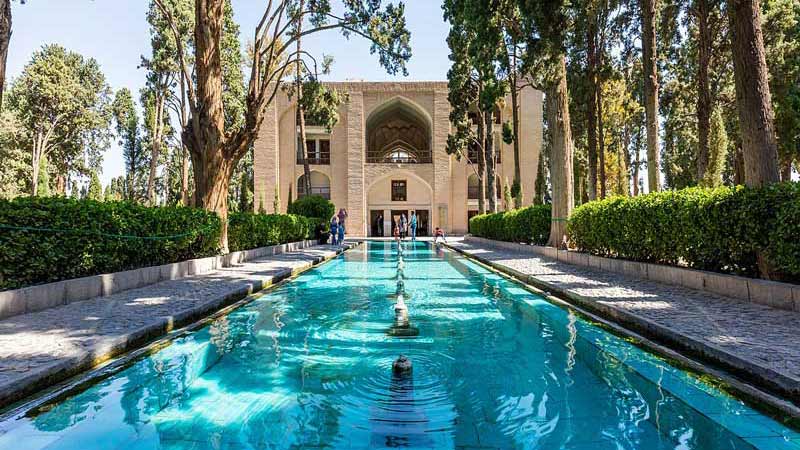
Akbarieh Garden in Birjand
The Akbarieh Garden is another Iranian garden that has gained international recognition, dating back to the Qajar era. This garden and its building were the most important governmental complex in Birjand, serving as the seat of government for several Emirs of the Alam dynasty, including Amir Alam Khan Heshmat al-Mulk, Mohammad Ibrahim Khan Shokat al-Mulk, and Asadollah Alam.
The beautiful Akbarieh Garden covers an area of 45,000 square meters. Its components include a mansion, entrance gate, garden area, mosque, pool, and the walls of the storage barn and stable. The mansion, located on the southern side of the garden, consists of three separate sections, built over different periods. The eastern front is the oldest part, constructed during the time of Amir Alam Khan Heshmat al-Mulk.
The central section is considered the most prominent part of the complex, comprising corridors, rooms, the main hall, vestibules, the pool house, dome house or foreign hat, and the mirror room. The western part, dating back to the Pahlavi era, includes the entrance stairs, forecourt, rooms, a corridor on the upper floor, and several rooms used as storage and garage on the lower floor.
The Akbarieh Garden remained the property of the Alam family until 1976, after which it was endowed by Asadollah Alam for the construction of a museum. Since 1993, restoration work began to turn it into a museum, and it is currently under the management of the General Directorate of Cultural Heritage, Handicrafts, and Tourism of South Khorasan. This garden was registered as a national heritage site of Iran on June 10, 1999.
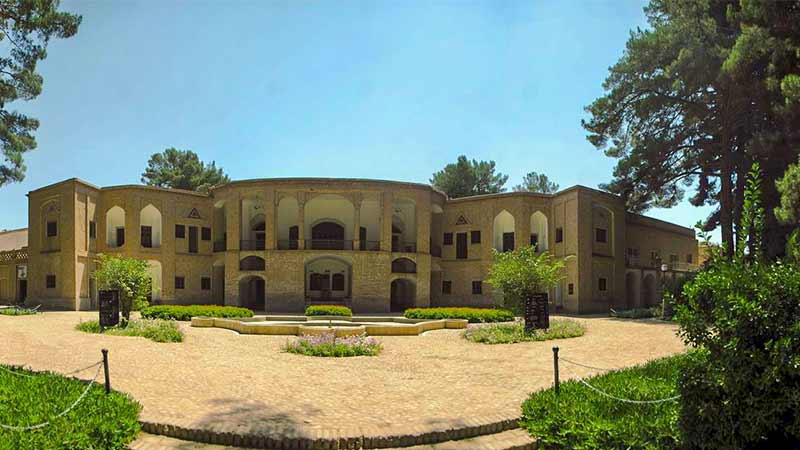
Dowlat Abad Garden in Yazd
The Dowlat Abad Garden in Yazd was established during the Zand dynasty in 1781 by Mohammad Taqi Khan, known as Khan-e Bozorg, the founder of the Khans of Yazd. He first built a qanat named Dowlat Abad and then used its water to create the Dowlat Abad Garden.
The Dowlat Abad Garden of Yazd covers an area of 4.6 hectares. Its windcatcher, standing 33.8 meters tall, is the tallest in Iran and the world. The garden’s structures include the Behesht Ayin Mansion, Mirror Hall, Tehrani Mansion, Eight-Sided or Windcatcher Mansion, North Entrance Mansion (related to the Behesht Ayin Garden), Tambour Hall, Watchtower, Camel Water Reservoir, and the Servants’ Quarters.
The garden is irrigated by the historic Dowlat Abad qanat, one of the most important and longest qanats in Yazd, originating from the Mehriz heights. After irrigating parts of Mehriz and powering several water mills, it reaches Yazd and this garden, then flows around the garden, watering the agricultural lands.
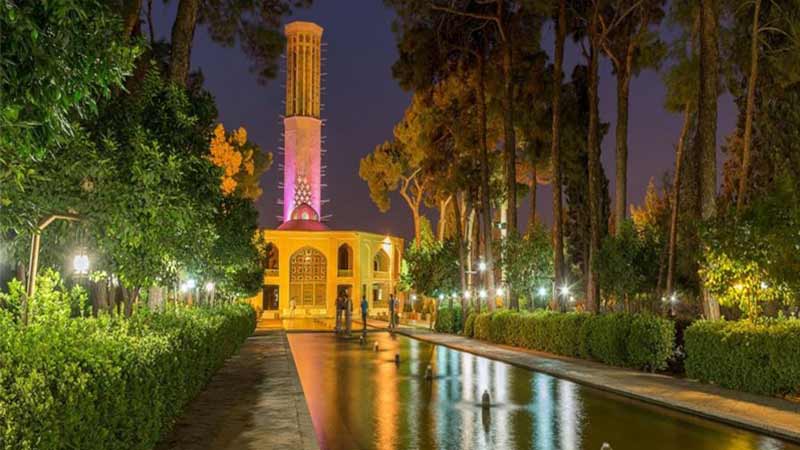
Pahlavanpour Garden in Yazd
The Mehriz district, known for its many gardens like the Pahlavanpour World Garden, is referred to as the Garden City of Yazd. This garden belongs to Ali Pahlavanpour, a merchant and hero from Mehriz, and was established in the Mazvaz neighborhood at the end of the Qajar era.
The Pahlavanpour Garden covers an area of five hectares. Its architectural style is a blend of Koshk and central courtyard styles. The components include the Sherbet-khaneh or Mansion, entrance complex, Winter House building in the west, Golestan Tower in the southeast, stable, storage, and carpet weaving and spinning workshops in the south. The garden is also watered by the permanent and world Hassan Abad Moshir qanat.
The Pahlavanpour Mansion has two and a half floors, comprising a hall, pool house, and alcoves. The Winter House building, dating back to the first Pahlavi era, includes living rooms, storage, and kitchen.
Abbasabad Garden in Behshahr
The Abbasabad Garden in Behshahr is considered the most important non-desert garden in Iran, located on the forested slopes of the Alborz Mountains. This garden, with its pristine nature and beautiful landscapes, was constructed around 1642 by Shah Abbas I Safavi as a recreational and secluded royal retreat.
After the Safavid era, the Abbasabad Garden fell into oblivion, buried in dense forests. Archaeologists unearthed parts of the garden and its remains from under the soil. The complex includes a terraced garden, bathhouse, water pressure-breaking brick towers, cobblestone roads, mill, Golbagh area (water distribution area), dam and its reservoir, and a central mansion in the lake.
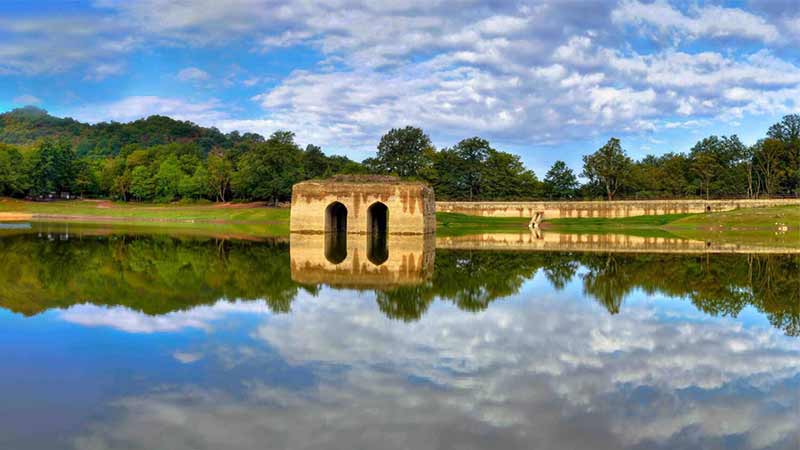
Conclusion
In conclusion, the Persian gardens, with their rich history and unique designs, offer a glimpse into Iran’s cultural and architectural heritage. From the ancient Pasargadae Garden in Shiraz, a model for many others, to the lush Shazdeh Mahan Garden in Kerman, representing the beauty of desert oases, each garden tells a story of the past. The Eram Garden in Shiraz, the Chehel Sotoun Garden in Isfahan, and the Fin Garden in Kashan, along with others like the Akbarieh Garden in Birjand and the Dowlat Abad Garden in Yazd, showcase the diversity and ingenuity of Iranian landscaping. The gardens are not just beautiful spaces; they are symbols of Persian art, history, and the human endeavor to harmonize nature and architecture. These gardens, spread across Iran and extending their influence to places like India and Afghanistan, reflect a legacy that continues to captivate and inspire visitors from around the world.



